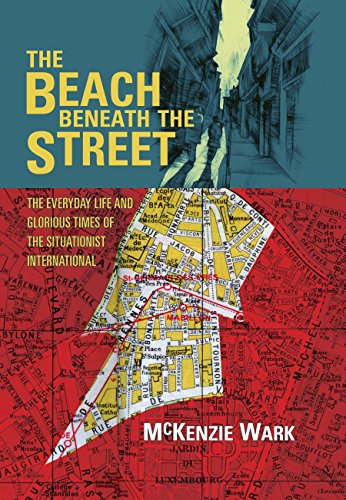Pier Vittorio Aureli: The Project of Autonomy: Politics and Architecture Within and Against Capitalism (2008)
Filed under book | Tags: · 1960s, 1970s, architecture, autonomy, capitalism, italy, operaismo, politics, theory

“The Project of Autonomy radically rediscusses the concept of autonomy in politics and architecture by tracing a concise and polemical argument about its history in Italy in the 1960s and early 1970s. Architect and educator Pier Vittorio Aureli analyzes the position of the Operaism movement, formed by a group of intellectuals that produced a powerful and rigorous critique of capitalism and its intersections with two of the most radical architectural-urban theories of the day: Aldo Rossi’s redefinition of the architecture of the city and Archizoom’s No-stop City. Readers are introduced to major figures like Mario Tronti and Raniero Panzieri who have previously been little known in the English-speaking world, especially in an architectural context, and to the political motivations behind the theories of Rossi and Archizoom. The book draws on significant new source material, including recent interviews by the author and untranslated documents.”
Publisher Princeton Architectural Press, 2008
Volume 4 of Buell Center/FORuM Project publication
ISBN 1568987943, 9781568987941
88 pages
McKenzie Wark: The Beach Beneath the Street: The Everyday Life and Glorious Times of the Situationist International (2011)
Filed under book | Tags: · 1950s, 1960s, architecture, everyday, life, philosophy, politics, situationists, spectacle, theory

“Over fifty years after the Situationist International appeared, its legacy continues to inspire activists, artists and theorists around the world. Such a legend has accrued to this movement that the story of the SI now demands to be told in a contemporary voice capable of putting it into the context of twenty-first-century struggles.
McKenzie Wark delves into the Situationists’ unacknowledged diversity, revealing a world as rich in practice as it is in theory. Tracing the group’s development from the bohemian Paris of the ’50s to the explosive days of May ’68, Wark’s take on the Situationists is biographically and historically rich, presenting the group as an ensemble creation, rather than the brainchild and dominion of its most famous member, Guy Debord. Roaming through Europe and the lives of those who made up the movement—including Constant, Asger Jorn, Michèle Bernstein, Alex Trocchi and Jacqueline De Jong—Wark uncovers an international movement riven with conflicting passions.
Accessible to those who have only just discovered the Situationists and filled with new insights, The Beach Beneath the Street rereads the group’s history in the light of our contemporary experience of communications, architecture, and everyday life. The Situationists tried to escape the world of twentieth-century spectacle and failed in the attempt. Wark argues that they may still help us to escape the twenty-first century, while we still can …”
Publisher Verso, London, 2011
ISBN 1844677206, 9781844677207
224 pages
Reviews: Christopher Collier (Mute), Anthony Hayes (Marx&Philosophy), Ian Birchall (Review31), Brettany Shannon (Society&Space), Ben Brucato (Humanity&Society), Karl Whitney (3AM), Vince Carducci (PopMatters), Andrew McCann (Sydney Review of Books), Gary Pearce (Steep Stairs), Jonathan Derbyshire (The Guardian), Andrew Blake (The Independent), Edwin Heathcote (Financial Times).
PDF (updated on 2019-2-9)
Comment (0)Scapegoat: Architecture/Landscape/Political Economy journal, No. 0-1 (2010-2011)
Filed under journal | Tags: · architecture, city, creative city, gentrification, landscape, political economy, politics, urbanism

“The second issue of SCAPEGOAT looks to current practices to intensify our concept of Service—as a problem. That is, how can we develop new models for self-management and mutual aid that move beyond unidirectional forms of service as clientelism and dependency? How can we think through service provision beyond the State? How can we privilege voluntary association and ethical reciprocity rather than volunteerism? How can new approaches to training and the intergenerational transmission of knowledge be radically re-organized? How has the rise of the populist Right coincided with mechanisms of gentrification and the ideologies of the so-called ’creative city’? How can we counter the predominance of economic metaphors in our attempts to articulate values and commitments? How could design services work in solidarity with the labour of extraction, construction, and maintenance?” (authors)
Issue 1: Service
Summer 2011
Editors: Jane Hutton, Etienne Turpin
28 pages

“The inaugural issue examines the centrality of the problem of Property because it is the literal foundation for all spatial design practices. We believe that this buried foundation must be exhumed. Architecture, landscape architecture, and urban design each begin with a space that is already drawn, organized, and formed by the concrete abstraction of the property lines. From our perspective, Property stands as the most fundamental, yet underestimated, point of intersection between architecture, landscape architecture, and political economy. What is a “site” except a piece of property? What are architecture and landscape architecture but subtle and consistent attempts to express determined property relations as open aesthetic possibilities? And, decisively, how can these practices facilitate other kinds of relation?” (authors)
Issue 0: Property
Fall 2010
Editors: Adrian Blackwell, Etienne Turpin
24 pages
SCAPEGOAT: Architecture | Landscape | Political Economy is an independent, not-for-profit, bi-annual journal designed to create a context for research and development regarding design practice, historical investigation, and theoretical inquiry.
As a mytheme, the figure of the scapegoat carries the burden of the city and its sins. Walking in exile, the scapegoat was once freed from the constraints of civilization. Today, with no land left unmapped, and with processes of urbanization central to political economic struggles, SCAPEGOAT is exiled within the reality of global capital. The journal examines the relationship between capitalism and the built environment, confronting the coercive and violent organization of space, the exploitation of labour and resources, and the unequal distribution of environmental risks and benefits. Throughout our investigation of design and its promises, we return to the politics of making as a politics to be constructed.
Publisher: Scapegoat Publications, Toronto
Editorial board: Adrian Blackwell, Adam Bobbette, Jane Hutton, Marcin Kedzior, Chris Lee, Christie Pearson, Etienne Turpin

